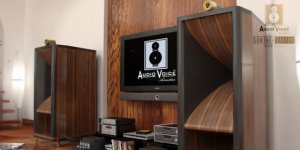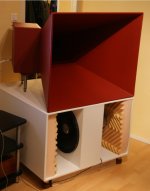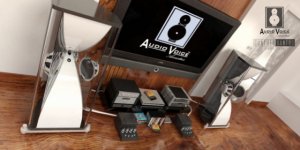I have 3 JBL 2360A horns with EV DH1A drivers...would my horns work as a Synergy horn (using a 10-15" EV woofer)? Someone told me no, but I have also been told yes. Does anyone know if it will, as I don't want to cut the horn up and find out it won't. I would like to make a 2 way Synergy horn that goes down to around 40Hz or so to mate up with my DTS-10 subs.
I was thinking that if I made a woofer plate for the woofers, and made a slot either on the top/bottom (I think this is the flattest area), I would not need a lot of area for the port. On the sides I would have more space, but it is not as flat as the top/bottom, plus the drivers would firing at each other very close to each other.
Ideas, suggestions?
tia,
Ron
I was thinking that if I made a woofer plate for the woofers, and made a slot either on the top/bottom (I think this is the flattest area), I would not need a lot of area for the port. On the sides I would have more space, but it is not as flat as the top/bottom, plus the drivers would firing at each other very close to each other.
Ideas, suggestions?
tia,
Ron
I think it would be risky. If you are planning to cross to the woofers at, say, 500Hz, then your woofer ports would need to be within 6.75" (absolute max, probably 5" would be more realistic) of the DH1A's diaphragm. That would put them on the flat part that feeds the diffraction slot, not sure how well that would work. At the least, I think you'd need to use an active (dsp) crossover, since the "first attempt" success rate with passive crossovers isn't high...
I'd honestly say the people that are skilled enough to do passive crossovers for a synergy know they are.At the least, I think you'd need to use an active (dsp) crossover, since the "first attempt" success rate with passive crossovers isn't high...
For everyone else, something like a MiniDSP (which I highly recommend) and multiple amp channels are mandatory.
As for the horn, hard to say. Almost all synergies are made with conical horns, not the diffraction kind. I can't claim to be smart enough to know how that will work. I can say the DH1A is a good driver for crossing to 15s since it has the stoutness to go nice and low.
I think it would be risky. If you are planning to cross to the woofers at, say, 500Hz, then your woofer ports would need to be within 6.75" (absolute max, probably 5" would be more realistic) of the DH1A's diaphragm. That would put them on the flat part that feeds the diffraction slot, not sure how well that would work. At the least, I think you'd need to use an active (dsp) crossover, since the "first attempt" success rate with passive crossovers isn't high...
Would I need to actually mount the woofers on the flat part of the adapter...or could they be remotely mounted, and ported to slots in the adapter that feeds the horn driver to the horn?
The adapter is 10" long.
Last edited:
If one would mount the woofers next to the diffraction slot (ports as close as possible to the vertical diffraction slot and time aligned with dsp) you could get the sound source to be close horizontally.
It's still a big gamble though. If the diffraction slot is narrow, the wave front should develop after that slot for the lower frequencies, right?
It's still a big gamble though. If the diffraction slot is narrow, the wave front should develop after that slot for the lower frequencies, right?
The jbl 2360a will go down to 200hz check the jbl specs may be lower 31"x31" mouth and 32" depth
Also read what it says about plane wave tube measurements on on 2360a horn ( jbl 2445j)
124" mouth is about 110hz
My hunch is your ev-dh1a will go down low as well but spl limited bear in mind this is for high spl not home situ
I would make a synergy style horn out of wood for the EV, sell the jbl horns after satisfied
Incorporate a sub within the synergy dimensions if need be
Also read what it says about plane wave tube measurements on on 2360a horn ( jbl 2445j)
124" mouth is about 110hz
My hunch is your ev-dh1a will go down low as well but spl limited bear in mind this is for high spl not home situ
I would make a synergy style horn out of wood for the EV, sell the jbl horns after satisfied
Incorporate a sub within the synergy dimensions if need be
Ditto what charlie2 sez. Making a wood horn isn't really too hard if you have access to a table saw and don't making a "sled" for it. See my sig spreadsheet for lots of help.
edit: I would skip the anti-waistbanding "2nd flare" if you are going that low, though. Your horn will hold directivity down to near the modal region in most rooms, so not much need to worry about waistbanding.
edit: I would skip the anti-waistbanding "2nd flare" if you are going that low, though. Your horn will hold directivity down to near the modal region in most rooms, so not much need to worry about waistbanding.
Last edited:
Woofer ports should be within a quarter wavelength of your compression driver xover point
Look at danleys designs
No need to to cut them in to the horn near to the throat.
This requirement is for compression drivers that need to be crossed high around 1k etc
But crossing at around 2'3'4 hundred hz is closer to the mouth than the throat
Look at danleys designs
No need to to cut them in to the horn near to the throat.
This requirement is for compression drivers that need to be crossed high around 1k etc
But crossing at around 2'3'4 hundred hz is closer to the mouth than the throat
Ditto what charlie2 sez. Making a wood horn isn't really too hard if you have access to a table saw and don't making a "sled" for it. See my sig spreadsheet for lots of help.
edit: I would skip the anti-waistbanding "2nd flare" if you are going that low, though. Your horn will hold directivity down to near the modal region in most rooms, so not much need to worry about waistbanding.
Woofer ports should be within a quarter wavelength of your compression driver xover point
Look at danleys designs
No need to to cut them in to the horn near to the throat.
This requirement is for compression drivers that need to be crossed high around 1k etc
But crossing at around 2'3'4 hundred hz is closer to the mouth than the throat
Thanks guys! So if I want to use the EV DH1As (I have 3 spares
I can go up to what ever can fit in the door which is 36" wide...leaving maybe 32" max for the narrowest dimension. I have 5' max depth behind my AT screen available. I was thinking around 3-4' wide, 3-4' tall, and 30" depth (without the EV DH1A driver installed).
I am retired and on a limited budget so that is why I am trying to use my drivers. If other woofers would work better that can be had for around $100 each please let me know (I have zero problem buying used drivers).
My front screen is 15' wide so that is the room I have to play with, and my MLP is about 12' from the screen.
tia,
Ron
Last edited:
Here are 3 design possibilities I like... The first one is my favorite. The 2nd one I like, but I don't want to have to use a bass bin.
Questions:
Pic #1, I like the tower style, but will it have reflection problems due to the flare going to the ceiling and floor?
Pic #2, could this be a solution for me, without a bass bin, and getting down to 40-60Hz?
Pic #3, another variation of #1, but I would not make it out of plexi.
I would be making them out of MDF, and at most painting them a color for a finished look.
Suggestions?
Questions:
Pic #1, I like the tower style, but will it have reflection problems due to the flare going to the ceiling and floor?
Pic #2, could this be a solution for me, without a bass bin, and getting down to 40-60Hz?
Pic #3, another variation of #1, but I would not make it out of plexi.
I would be making them out of MDF, and at most painting them a color for a finished look.
Suggestions?
Attachments
Last edited:
I'd recommend downloading the spreadsheet and seeing what kind of dimensions and coverage angles give you what kind of performance. It just takes a few seconds to play, less time than typing in questions here. (If you don't have Xcel, then there is a freeware alternative -- see the first sheet of the pdf file for Synergycalc).
40 to 60Hz isn't going to happen within the range where the horn gives any gain or pattern control in a 36" horn, but you can still get output down there, where the assembly will then act like a sealed or ported box below the horn's pattern control frequency. True bass horns are monstrously large!
It is possible to feed the horns via a port/length, but you absolutely need to model it (in HornResponse or Akabak) before building. Just "winging it" would give about zero chance of working. Also, the feed port length should never go above or even near 1/4 wavelength at the driver's higher crossover frequency or you'll start to get resonant pipe effects from it (which might not show up in the models, btw).
40 to 60Hz isn't going to happen within the range where the horn gives any gain or pattern control in a 36" horn, but you can still get output down there, where the assembly will then act like a sealed or ported box below the horn's pattern control frequency. True bass horns are monstrously large!
It is possible to feed the horns via a port/length, but you absolutely need to model it (in HornResponse or Akabak) before building. Just "winging it" would give about zero chance of working. Also, the feed port length should never go above or even near 1/4 wavelength at the driver's higher crossover frequency or you'll start to get resonant pipe effects from it (which might not show up in the models, btw).
I tried to download this and I get an error "You don't have permission to access /~mortenw/gnumeric/gnumeric-1.10.16-20110616.exe on this server.". Am I doing something wrong?
Here is the web address I was using.
403 Forbidden
Here is the web address I was using.
403 Forbidden
All you have to do is click on the link in bwaslo's signature above your post. The one that says SynergyCalc/ (<- or this one  )
)
It will open a listing containing Synergy Calc v5.xls. That's the spread sheet you want to get. It downloads just fine.
You'll need Office or one of the free alternatives Bill mentioned to be able to open the spread sheet. Or are you having problems with one of the freeware Office programs?
It will open a listing containing Synergy Calc v5.xls. That's the spread sheet you want to get. It downloads just fine.
You'll need Office or one of the free alternatives Bill mentioned to be able to open the spread sheet. Or are you having problems with one of the freeware Office programs?
Last edited:
Thanks, but it says not for Windows. I will check in the morning and see if I still have Excel. Hopefully I do so I can try and get a horn put together for now, and then test as a horn with REW. Then I will be able to see what woofers to get for it. Hopefully this will sound as good as my current horn sounds...if so then it will be time to start making some big ones!
The only speaker DIY I did before I did my bass bins was in HS, and they were not very good. My Bass bins were designed by someone else and sound great, but are just not what I want for my setup anymore. An all in one full range box is what I need now.
I wish that I would have known you were a Synergy guy when we were up in Oregon last month... I would have asked to have a listen to your setup.
Last edited:
- Home
- Loudspeakers
- Multi-Way
- Synergy DIY


